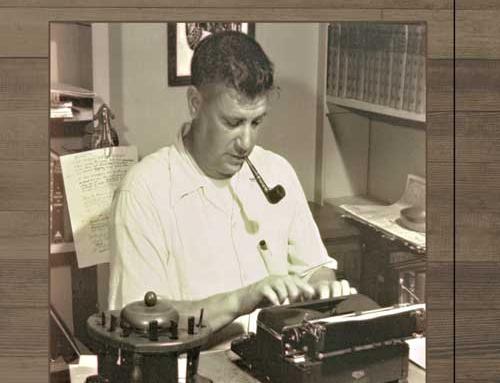As a writer, teacher, and lecturer, Jesse Stuart extended his life to the far corners of the world. He traveled to all but one of the United States and to ninety countries on six continents. His global life began in the 1930s with a Guggenheim Fellowship that supported his travels to the British Isles and Europe.
On July 9, 1937, he sailed from New York and landed in Scotland nine days later. Eager to explore his ancestral land and armed with $2000 in Guggenheim support funds, Stuart visited almost every European country before returning home. During his fourteen months abroad, he made dozens of new friends and was even a guest at the home of Lord and Lady Astor for two weeks. Stuart also got to see the tomb of his longtime idol, Robert Burns.
 During his European travels, Jesse enjoyed an active social life, which he reported in detail to his family and a few close friends. His father told a neighbor that he “fully expected” Jesse to “marry one of those damned furriners.”
During his European travels, Jesse enjoyed an active social life, which he reported in detail to his family and a few close friends. His father told a neighbor that he “fully expected” Jesse to “marry one of those damned furriners.”
Jesse’s research goal was “to study the likeness in literature and folklore” between the Scottish highlanders and their counterparts in the Kentucky mountains. During his fellowship year, he also worked on five major book projects.
Jesse applied for a renewal of his fellowship, but it was denied, so he returned to America, arriving in New York on July 12, 1938, with seven dollars in his pocket. Surprisingly, his return to America was hailed by the New York press and newspapers across the country. Beyond Dark Hills had just been published, and Jesse Stuart was suddenly a media darling. New York reporters reveled in his observations about European people and customs, quoting him on topics that ranged from food to fashion, and from politics to pretty women. According to the press, he was “hatless, broke, and tickled to death” to be home. Despite the explosion of his popularity, he was still penniless and had to borrow money just to get back to Kentucky.
Stuart’s travels in the 1930s whet his appetite for a lifetime of global adventures. In August 1949, Jesse and his wife Naomi Deane, along with their friends Gus and Lena Wells Voiers, took a trip to Europe aboard the Queen Elizabeth. During the 1960-61 school year, Jesse taught for a year at the American University in Cairo, Egypt. A year later, from September 1962 – February 1963, he went on a World Lecture Tour sponsored by the United States Information Service of the U.S. State Department. In 1969, Jesse and his wife toured Africa and southern Europe.
In the fall of 1973, the Stuarts had planned a tour of the Far East, but on October 25, six days before their scheduled departure, Jesse suffered his fifth heart attack and remained hospitalized for a month. Three years later, in October 1976, the Stuarts finally took their vacation to the Orient.
Jesse Stuart spent the last eight years of his life in hospital beds and wheelchairs and died on February 17, 1984. But he had traveled the world while he was young. His grand adventures began with his Guggenheim Fellowship and what a great learning experience it had been. “I never knew America,” Jesse reflected, “until I went to Europe.”
If you are interested in reading more about Jesse Stuart’s life and travels, I encourage you to read Jesse Stuart: An Extraordinary Life which is available at the Jesse Stuart Foundation at 4440 13th Street in Ashland. For more information, call 606-326-1667 or email jsf@jsfbooks.com.
James M. Gifford, Ph.D.
CEO & Senior Editor
Jesse Stuart Foundation
As a writer, teacher, and lecturer, Jesse Stuart extended his life to the far corners of the world. He traveled to all but one of the United States and to ninety countries on six continents. His global life began in the 1930s with a Guggenheim Fellowship that supported his travels to the British Isles and Europe.
On July 9, 1937, he sailed from New York and landed in Scotland nine days later. Eager to explore his ancestral land and armed with $2000 in Guggenheim support funds, Stuart visited almost every European country before returning home. During his fourteen months abroad, he made dozens of new friends and was even a guest at the home of Lord and Lady Astor for two weeks. Stuart also got to see the tomb of his longtime idol, Robert Burns.
During his European travels, Jesse enjoyed an active social life, which he reported in detail to his family and a few close friends. His father told a neighbor that he “fully expected” Jesse to “marry one of those damned furriners.”

Jesse’s research goal was “to study the likeness in literature and folklore” between the Scottish highlanders and their counterparts in the Kentucky mountains. During his fellowship year, he also worked on five major book projects.
Jesse applied for a renewal of his fellowship, but it was denied, so he returned to America, arriving in New York on July 12, 1938, with seven dollars in his pocket. Surprisingly, his return to America was hailed by the New York press and newspapers across the country. Beyond Dark Hills had just been published, and Jesse Stuart was suddenly a media darling. New York reporters reveled in his observations about European people and customs, quoting him on topics that ranged from food to fashion, and from politics to pretty women. According to the press, he was “hatless, broke, and tickled to death” to be home. Despite the explosion of his popularity, he was still penniless and had to borrow money just to get back to Kentucky.
Stuart’s travels in the 1930s whet his appetite for a lifetime of global adventures. In August 1949, Jesse and his wife Naomi Deane, along with their friends Gus and Lena Wells Voiers, took a trip to Europe aboard the Queen Elizabeth. During the 1960-61 school year, Jesse taught for a year at the American University in Cairo, Egypt. A year later, from September 1962 – February 1963, he went on a World Lecture Tour sponsored by the United States Information Service of the U.S. State Department. In 1969, Jesse and his wife toured Africa and southern Europe.
In the fall of 1973, the Stuarts had planned a tour of the Far East, but on October 25, six days before their scheduled departure, Jesse suffered his fifth heart attack and remained hospitalized for a month. Three years later, in October 1976, the Stuarts finally took their vacation to the Orient.
Jesse Stuart spent the last eight years of his life in hospital beds and wheelchairs and died on February 17, 1984. But he had traveled the world while he was young. His grand adventures began with his Guggenheim Fellowship and what a great learning experience it had been. “I never knew America,” Jesse reflected, “until I went to Europe.”
If you are interested in reading more about Jesse Stuart’s life and travels, I encourage you to read Jesse Stuart: An Extraordinary Life which is available at the Jesse Stuart Foundation at 4440 13th Street in Ashland. For more information, call 606-326-1667 or email jsf@jsfbooks.com.
James M. Gifford, Ph.D.
CEO & Senior Editor
Jesse Stuart Foundation



